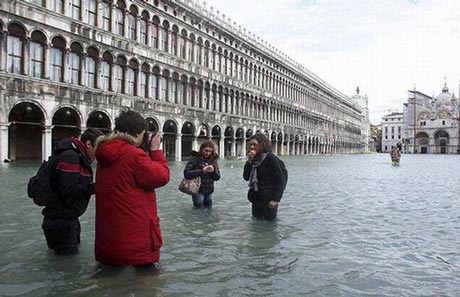Save the 'love city' with fat
The city of Venice in Italy will stop subsidence if authorities allow scientists to drop a type of fat into the sea, leading architects declare.

A Dutch tourist winds through the streets of Venice when the city is submerged in water.Photo: Reuters.
Spread across hundreds of small islands in the Venetian lagoon along the Adriatic Sea in northeastern Italy, Venice is known as "the city of love". It was built by the Romans in 442. But every year, every day near Christmas, the city is submerged in water due to the rising tide. Scientists fear global warming will make Venice's sea level rise higher in the future, exacerbating the flooding in Venice.
Facing that situation, scientists decided to create a project called "Future Venice" on February 22. The goal of the project is to prevent flooding in the "love city". According to Telegraph, Rachel Armstrong and Neil Spiller - two architects of the University of London, England - join the project.

Visitors wade to take pictures in Venice.Photo: xcitingfun.net.
Two British architects affirmed that they could release a special kind of fat that turns carbon dioxide in water into artificial limestone.
"This measure is based on the chemical properties of fat and water. The fat droplets will create countless hard limestone particles capable of protecting construction works , " said Armstrong female architect.
Neil, a professor of architecture, said: "The stones that support the city of Venice are sinking down to Venice. If we can bring fat down to the rocks to create limestone, the sinking phenomenon gradually Venice will be slower or stop altogether ".
Currently the city of Venice is considering a plan to build a series of steel water gates around the city to control the rise of the tide in Venice. Two British architects affirmed their measures have more advantages than the plan to build water gates. However, Armstrong said the solution is being tested and can only be applied in the next 3-5 years.
- 9 odd effects of love
- Strange facts that science explains about love
- 4 wrong thoughts about love that not everyone knows
- New discoveries of love
- Interesting facts about love
- 'What is love?' through a scientific perspective
- 4 new discoveries about love that amaze you
- How many seconds do women need to have love?
- Why are people 'blind' when they love?
- Love is like an addiction
- Psychological reactions after being confessed
- Sad love story behind the love locks around the world
 Is the magnetic North Pole shift dangerous to humanity?
Is the magnetic North Pole shift dangerous to humanity? Washington legalizes the recycling of human bodies into fertilizer
Washington legalizes the recycling of human bodies into fertilizer Lightning stone - the mysterious guest
Lightning stone - the mysterious guest Stunned by the mysterious sunset, strange appearance
Stunned by the mysterious sunset, strange appearance